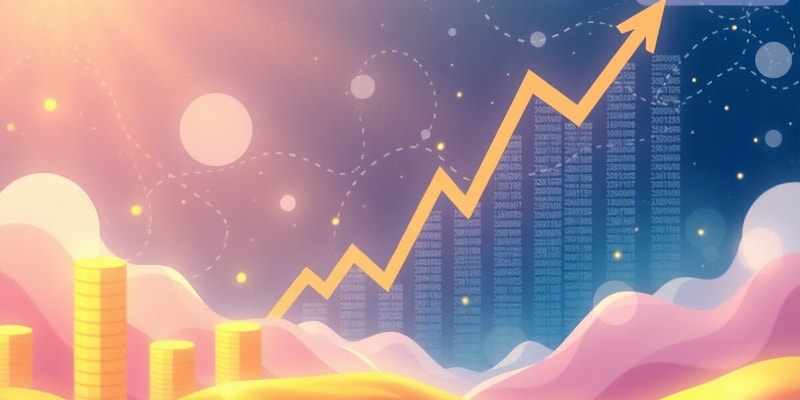Podcast
Questions and Answers
What is the primary purpose of inferential statistics?
What is the primary purpose of inferential statistics?
Which of the following is NOT a measure of central tendency?
Which of the following is NOT a measure of central tendency?
What statistical method would be used to determine the typical value for measurements in a dataset?
What statistical method would be used to determine the typical value for measurements in a dataset?
Which statement about descriptive statistics is true?
Which statement about descriptive statistics is true?
Signup and view all the answers
What does GDP measure?
What does GDP measure?
Signup and view all the answers
Which of the following is an example of a non-economic factor influencing the economy?
Which of the following is an example of a non-economic factor influencing the economy?
Signup and view all the answers
Which describes the consumer price index (CPI)?
Which describes the consumer price index (CPI)?
Signup and view all the answers
What is the purpose of measuring inflation?
What is the purpose of measuring inflation?
Signup and view all the answers
What is the formula to calculate the unemployment rate?
What is the formula to calculate the unemployment rate?
Signup and view all the answers
Which type of unemployment is caused by economic downturns or recessions?
Which type of unemployment is caused by economic downturns or recessions?
Signup and view all the answers
What are the components of GDP represented by the formula GDP = C + I + G + NX?
What are the components of GDP represented by the formula GDP = C + I + G + NX?
Signup and view all the answers
What does 'natural rate of unemployment' refer to?
What does 'natural rate of unemployment' refer to?
Signup and view all the answers
Which of the following is NOT a characteristic of the business cycle?
Which of the following is NOT a characteristic of the business cycle?
Signup and view all the answers
What does an increase in Aggregate Demand (AD) typically indicate?
What does an increase in Aggregate Demand (AD) typically indicate?
Signup and view all the answers
Which of the following best describes 'sticky' input prices?
Which of the following best describes 'sticky' input prices?
Signup and view all the answers
In the context of the AS/AD model, what does 'AS' stand for?
In the context of the AS/AD model, what does 'AS' stand for?
Signup and view all the answers
Study Notes
Descriptive vs. Inferential Statistics
- Descriptive statistics summarize and describe data.
- Inferential statistics use sample data to draw conclusions about populations.
Measures of the Economy and Economic Health
-
Gross Domestic Product (GDP): total output of final goods and services in a time period.
- Excludes intermediate goods to avoid double-counting.
- Nominal: Using current prices.
- Real: Adjusting for inflation.
-
Consumer Price Index (CPI): measures the average change in prices paid by urban consumers.
- A basket of goods is selected based on typical consumer spending.
- Base year: set to 100.
-
Inflation: increase in prices over time.
- Often measured by CPI.
- Deflation: prices decrease.
-
Unemployment Rate: percentage of unemployed people in the labor force.
- Unemployed individuals are those actively seeking work but are not currently employed.
The AD-AS Model
-
Aggregate Demand (AD): total demand for goods and services in an economy.
- AD = C + I + G + NX
- C: consumption
- I: investment
- G: government spending
- NX: net exports
- AD = C + I + G + NX
-
Aggregate Supply (AS): total supply of goods and services in an economy.
- Short-run Aggregate Supply (SRAS): upward-sloping due to market power and sticky input prices.
- Long-run Aggregate Supply (LRAS): vertical line, representing full employment output (potential output).
- Shifts in the AS curve can be caused by factors like changes in business tax rates, input costs, or technology.
Types of Unemployment
- Cyclical Unemployment: caused by economic downturns or recessions.
- Frictional Unemployment: time lags in matching jobs with workers.
- Structural Unemployment: mismatch between worker skills and employer demands.
- Natural Rate of Unemployment (NRU): the sum of frictional and structural unemployment, considered a "healthy" level of unemployment.
Economic Uncertainty
- Business cycles can exhibit uncertainty in:
- Duration: how long the cycle lasts.
- Severity: how bad the cycle is.
- Distribution: how it impacts different groups and places.
Economic Indicators
- GDP: measures the total value of goods and services produced in a country.
- CPI: measures the rate of inflation.
- Unemployment Rate: indicates the level of joblessness.
- GPI: measures the environmental and social impact of economic activity.
Studying That Suits You
Use AI to generate personalized quizzes and flashcards to suit your learning preferences.
Description
Test your knowledge on descriptive and inferential statistics as they relate to economic measures like GDP and CPI. Understand the importance of inflation, deflation, and unemployment rate in assessing economic health. This quiz will challenge your understanding of key economic concepts and models.




